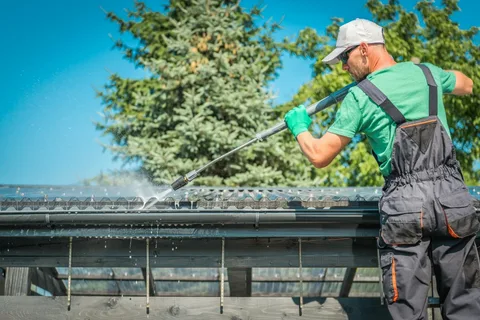When it comes to protecting a building’s structural integrity, certain systems work silently in the background to prevent damage long before it’s visible. One of the most critical yet often overlooked systems is the gutter system. While the roof takes the brunt of the elements, the gutter system acts as its partner—responsibly guiding water away from the structure to prevent long-term harm.
Without gutters—or with ones that are damaged or neglected—buildings face a wide array of issues. From water intrusion and rotting wood to cracked foundations and soil erosion, the consequences can be expensive and time-consuming to fix. That’s why understanding how gutters work, how to maintain them, and when to take action is vital for any property owner.
This guide breaks down how gutters function, what maintenance they require, how to spot problems early, and how to handle repairs or replacements when needed.
Understanding the Role of Gutters
A properly functioning gutter system is more than just a trim piece running along the edge of a roof. Gutters collect rainwater and melted snow from the roof and direct it through downspouts away from the foundation. This redirection prevents erosion, protects siding and windows, and reduces the risk of basement flooding.
Over time, even the best gutters are susceptible to wear and tear. Debris accumulation, rust, sagging, joint separation, and weather damage can compromise the effectiveness of the entire system. Early intervention and proper maintenance can prevent many of these issues from escalating into major repairs.
Common Types of Gutter Materials
Before addressing problems, it’s helpful to know what kind of gutters you may be dealing with, as different materials age and react to environmental conditions differently.
1. Aluminum
Lightweight, rust-resistant, and affordable, aluminum is the most popular material. It comes in various colors and is easy to install or repair.
2. Vinyl
Vinyl gutters are inexpensive and won’t corrode, but they can crack over time—especially in extreme cold or under prolonged UV exposure.
3. Galvanized Steel
Strong and durable, galvanized steel can last many years, but it is prone to rust if the protective zinc coating wears off.
4. Copper
High-end copper gutters are known for their aesthetics and longevity. While expensive, they develop a protective patina over time and rarely require replacement.
5. Zinc
Zinc offers a similar profile to copper in both durability and cost, often chosen for historical buildings or luxury homes.
Each material has its pros and cons in terms of lifespan, maintenance, and repair approach.
Most Common Gutter Problems
Gutters are exposed to the elements year-round, and they are bound to experience issues without consistent maintenance. Here are some of the most typical problems that arise:
Clogged Gutters
Leaves, sticks, dirt, and roofing debris are the main culprits here. Clogs block water flow, causing gutters to overflow. This can result in siding damage and roof leaks.
Leaking Joints and Holes
Seams and corners are prone to leaks over time. Patching or sealing these areas is often a straightforward fix, but the longer it’s delayed, the worse it can get.
Sagging or Detached Gutters
Heavy debris, ice dams, or broken hangers can cause gutters to sag. This affects proper drainage and can damage fascia boards.
Improper Slope
Gutters should slope slightly toward the downspouts. Poor slope results in stagnant water, which increases the risk of rust, insect breeding, and overflow.
Rust and Corrosion
Metal gutters can begin to rust over time, especially in climates with high humidity or salt in the air. Corrosion weakens structural integrity.
Downspout Disconnection
If downspouts pull away from the system or clog internally, water may pool around the home, leading to foundation issues.
How to Inspect Gutters Properly
Gutter issues are easier to solve when caught early. It’s a good practice to inspect gutters at least twice a year—preferably in the spring and fall—and after major storms. Here’s a checklist for thorough inspection:
- Visual Check from the Ground: Look for sagging sections, visible rust, or any disconnections.
- Inspect Joints and Seams: These are the most common points for leaks.
- Check for Pooling Water or Overflow Marks: These signs often mean poor drainage or blockages.
- Flush with Water: Run a hose through the gutter system to detect clogs or uneven flow.
- Inspect Downspouts: Ensure water flows freely and exits away from the foundation.
Preventative Maintenance Practices
Like many home systems, a little prevention can go a long way in avoiding costly issues. Here are effective ways to keep your gutters working at their best:
Clean Regularly
Cleaning gutters 2–4 times per year keeps them free of debris. For homes with many trees nearby, more frequent cleaning may be necessary.
Install Gutter Guards
Screens, covers, and mesh inserts help reduce the amount of debris entering the gutter. While not maintenance-free, they cut down on cleaning significantly.
Trim Overhanging Branches
Trees that extend over your roofline are a major source of gutter debris. Keeping them trimmed helps maintain a clean system.
Seal Leaky Seams
Using a waterproof sealant on joints and corners can stop leaks and prevent rust from spreading.
Ensure Proper Drainage
Downspouts should discharge water several feet from the home’s foundation. Add extensions if necessary to avoid erosion and water infiltration.
When Repair Is Necessary
Not all problems require full replacement. In fact, a large percentage of issues can be resolved through effective gutter repair. Here are a few situations where targeted repairs can extend the life of your system:
- Sealing isolated leaks or patching holes
- Reattaching loose hangers or brackets
- Replacing damaged sections or connectors
- Correcting the slope of the system for proper water flow
- Clearing stubborn clogs in downspouts
Whether you’re dealing with a detached section after a storm or a few small leaks along the seams, gutter repair can restore function without the cost of a full replacement.
Knowing When to Replace the Whole System
There comes a point when repairs are no longer effective, or the cost of fixing outweighs the benefit. Consider a full gutter replacement if:
- More than 30% of the system is rusted or cracked
- Sagging is widespread and consistent
- The gutters are pulling away from the house and damaging the fascia
- The system is outdated or improperly sized for your home
- Water damage has already occurred to walls or foundation
In these cases, replacement ensures long-term protection and can even improve your home’s curb appeal.
Seamless vs. Sectional: Upgrade Considerations
If you’re upgrading, seamless gutters are worth considering. Unlike traditional sectional gutters, which are pieced together and joined with connectors, seamless gutters are custom-fabricated in one continuous run. This reduces the number of joints and significantly lowers the risk of leaks.
Other modern upgrades include:
- Built-in gutter guards
- Decorative fascia covers
- Durable powder-coated finishes
- Larger downspouts for increased flow capacity
These enhancements can be included during a replacement or major gutter repair to increase durability and efficiency.
Hiring a Professional vs. DIY Repairs
Some repairs can be handled with a ladder, sealant, and a few tools. However, safety and long-term quality should always be considered. Climbing roofs or handling metal edges can be dangerous without the right training.
DIY Repairs May Include:
- Cleaning and flushing gutters
- Replacing fasteners or brackets
- Sealing small leaks
- Adding downspout extensions
Professional Repairs Are Best For:
- Realigning entire gutter runs
- Replacing rusted or damaged sections
- Seamless system fabrication
- Diagnosing drainage issues impacting the home
Hiring an experienced professional ensures that repairs are done right the first time and that potential issues are caught early.
Final Thoughts
Your gutters may seem like a small part of your home’s exterior, but their impact is enormous. From protecting the foundation to preserving siding and landscaping, they are your first defense against water damage. Regular inspection and preventative maintenance are the keys to longevity and performance.
When issues arise, don’t ignore them. Whether it’s a loose bracket or a section that needs realignment, addressing it promptly with appropriate gutter repair can save you from costly future problems.
Taking care of your gutters is taking care of your home. With the right knowledge and action, you can ensure they function effectively through every season, rainstorm, and freeze.


